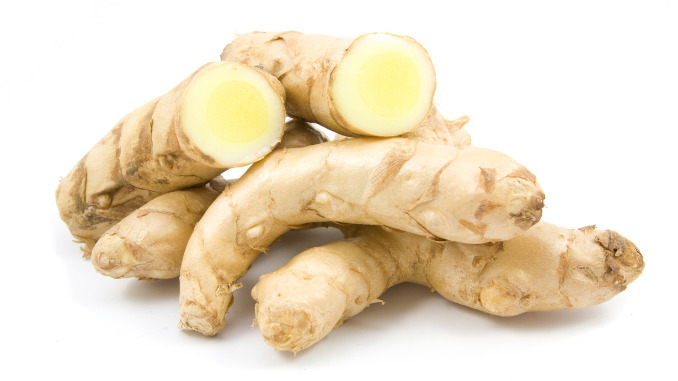Know in one minute about White turmeric benefits
|
Introduction
White turmeric (Curcuma zedoaria) is a medicinal tuber plant and ancient spice belonging to the Zingiberaceae family. The plant is 50 cm tall and has green leaves with brownish-purple veins that narrow at the base. White turmeric has large fleshy tubers that look like ginger on the outside and turmeric on the inside (1). White turmeric benefits are as follows.
After maturity white turmeric rhizome becomes thin brown or gray and has a hard dark orange interior. Dried rhizomes have an aromatic, camphoraceous smell, like turmeric and mango, and a strong bitter aftertaste. White turmeric is available in a powder, or dried and even sliced form.
Traditionally, the dried rhizome is used in Indonesia, China, Japan, Korea, and India to treat various diseases. It is used to treat menstrual disorders, indigestion, vomiting, wound, ulcers, cancer, and skin disorders. White turmeric is used in various ayurvedic preparations like Dasamularishtam, Valiya Rasnadi Kashayam, etc. (2).
Geographical distribution
White turmeric is a native plant from Bangladesh, India, Brazil, and Sri Lanka. Also found in subtropical regions (Southeast Asia, Thailand, Indonesia, Japan, and China).
Common name
It is also known as yellow zedoary, zedoaria or gajutsu, Ezhun (Chinese), Indian arrowroot, Amba Haldi.
Components
White turmeric rhizome is a rich natural source of sesquiterpenes, including furanodiene, germacrone, curdione, neocurdione, curcumenol, isocurcumenol, aerugidiol, zedoarondiol, curcumenone and curcumin.
It also contains alkaloids, saponins, flavonoids, glycosides, and carbohydrates. Apart from this, phenols, tannins, and phytosterols are also present in white turmeric. This perennial plant is a rich source of essential oils, starch gums, etc (3).
White turmeric benefits
1. Good for the brain
White turmeric benefits are due to phenol and flavonoids that act as natural antioxidants. These antioxidants improve memory and learning impairment in the brain (4). Moreover, curcumenol found in white turmeric reduces the inflammation of brain cells thus treating various brain diseases (5).
2. Lower cholesterol and glucose level
The presence of high phenolic and flavonol contents in white turmeric reduces the cholesterol level. It converts the cholesterol into bile acids and increases its excretion. Thus, the intake of white turmeric tea for 60 days decreases the cholesterol level and glucose in the body (6).
3. Treat blood clotting
Ermanin and curcumin found in white turmeric inhibit the clumping of platelets in the blood thus preventing blood clotting (7). It also reduces plaque that builds up inside the arteries thus protecting the body from heart disease (8).
4. Treat inflammation
White turmeric rhizomes contain sesquiterpenes like furanodiene, furanodienone, and curcuzedoalide which reduce swelling and are used for the treatment of inflammatory diseases. (9)
5. Treat pain
White turmeric contains tannins, saponins, steroids, alkaloids, reducing sugars, curcumenol, and flavonoids. These compounds reduce tissue swelling and joint pain. It also overcomes stress and anxiety in rheumatoid arthritis patients (10).
6. Treat cancer
White turmeric contains polyphenolic compounds and other potent antioxidants such as beta-carotene and ascorbic acid. It also contains curcumenone, curcumenol, Isocurcumenol, and curcuzedoalide (11). These compounds suppress the growth of cancer cells such as ovarian, cervical, nasopharyngeal, leukemic, lung, gastric, and breast cancer cells. It also induces apoptosis without inducing toxicity to the normal cells (12).
7. Heal wounds
Polysaccharides found in the rhizomes of white turmeric heal wounds by promoting skin regeneration and accelerating wound contraction. It also increases collagen synthesis, deposition, and the formation of new blood vessels at the wound site. Thus white turmeric accelerates skin repair in diabetic patients (13).
8. Reduce alcohol induces toxicity
Drinking excessive alcohol can cause health defects. White turmeric contains curcumenone that prevents drunkenness, decreases blood alcohol concentrations, and prevents alcohol-induced intoxication (14).
9. Fight against infections
White turmeric is a good source of tannin, flavonoid, and terpenoid. It also contains curcuminoids including curcumin and cinnamate. These compounds fight against various bacterial and fungal infections and protect the body from infection (15).
10. Treat fever
The presence of terpenoids in white turmeric reduces the body temperature and works similarly to paracetamol. Therefore, intake of white turmeric may be helpful to treat the fever and show antipyretic effect (16).
A side effect of white turmeric
1. Risk in pregnant women
White turmeric and its oil contain some components that can inhibit the formation of blood vessels. That results in damage to the supply of oxygen and nutrition to the embryo, which finally led to abortion (17).
However, a research study suggested that its taboo, white turmeric only kills cancer cells but precaution should be needed before consumption (18).
2. Thoroughly wash before use
It is important to wash white turmeric thoroughly and carefully before you eat because it can cause serious health issues (19).
Raw turmeric contains a high amount of crude protein and other water-soluble nutrients and, presumably, toxic constituents. Traditionally, it is washed multiple times in water for a long time to remove all toxic content.
How to eat white turmeric
White turmeric spice is eaten in salads, pickles, and aromatic tea. It can be used as an ingredient in curry powder and seafood dishes. A substitute for arrowroot and barley is also prepared from the rhizomes. This starch can be used as a dietary item for infants and convalescents due to its cooling and demulcent properties.
Q&A
1. How to remove turmeric stains from white clothes?
Firstly scrape off turmeric as soon as possible with a paper towel or a fingernail. Now you can apply detergent, hydrogen peroxide, lemon juice, or white vinegar to rid of stubborn turmeric stains. Can use white toothpaste, baking soda, corn starch, glycerin, or bleach to remove turmeric stains from white clothes.
2. What is white turmeric?
White turmeric closely resembles turmeric (Curcuma longa) in appearance. The rhizome of this plant is large, and fleshy, and has a warm, spicy, woody, and camphoraceous cineolic odor. Rhizome has a strong bitter taste when cut into small pieces. It contains sesquiterpene like curcumin and many more that have diverse biological activities.
